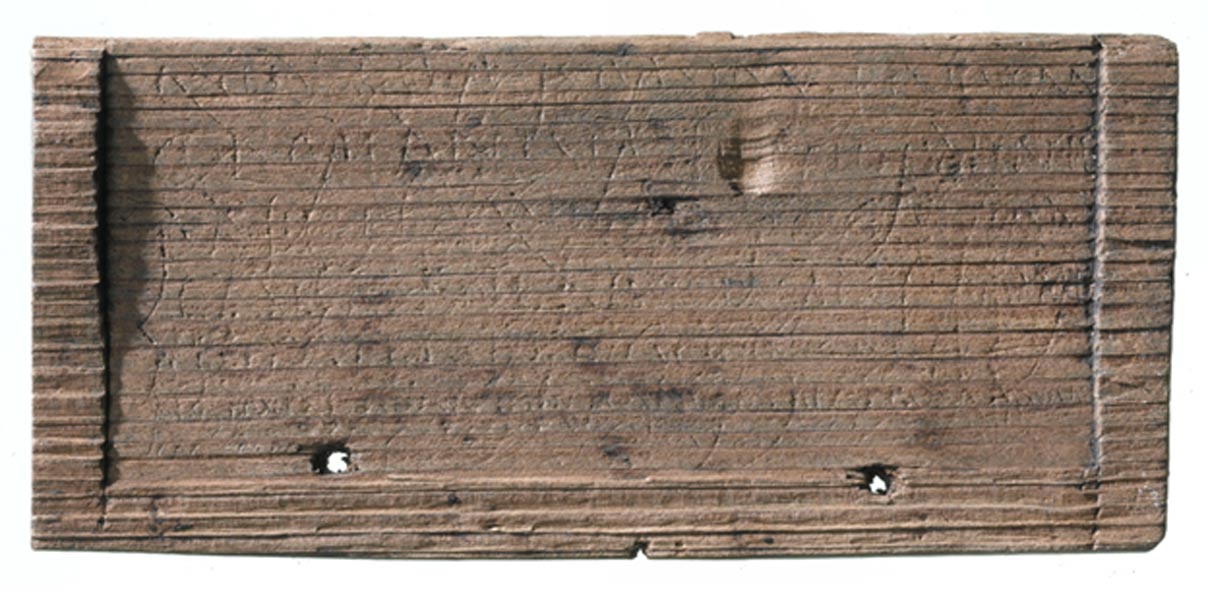Newly Discovered Ancient Roman Writing Tablets Provide Snapshots of Roman-Era London
Recently discovered ancient British Roman texts on wax-covered wood tablets with legal, correspondence, note-taking and accounting documents have been translated, and researchers are now releasing their findings to the world. The researchers say the texts, discovered during construction of a new building, provide important insight into Roman-Britain times.
“In the words of the people who lived, worked, traded with and administered Roman London, the Bloomberg tablets reveal the names, events, workings and organisation of the new city. One tablet features the earliest ever reference to London, preceding Tacitus’ citing of London in his Annals by 50 years,” says a press release from Museum of London Archaeology.
Across the Roman Empire, people used the tablets as we use paper today. A large cache was discovered as preparations were being made to build the European headquarters of the media company Bloomberg.

Roman writing tablets, 1 st – 2 nd century AD (public domain)
Before the find of 405 wax tablets, only 19 decipherable Roman tablets were known in London. More than 80 of the new documents have been deciphered, “providing an incredibly rare and personal insight into the first decades of Roman rule in Britain,” says MOLA.
One highlight from the tablet includes evidence of Julius Classicus, who led the Batavian revolt. Earlier on, in London, he was the prefect of the Sixth Cohort of the Nervians just after London was settled by Rome. In Rome, a cohort was a military unit consisting of 300 to 600 men and was one-tenth of a legion.
Batavia was located in what is now know as Netherlands. The Batavian revolt was in 69 and 70 AD. Some of the Roman troops defected to the rebels’ side, an event that Tacitus called “a deed of shame quite without parallel.”

Batavians defeating the Romans (public domain)
The team of researchers dated one tablet to between 43 and 53 AD, the period during which the Romans conquered Britain. Another contains the first reference to London, from between 65 and 80 AD.
The documents include a contract to bring 20 loads of provisions to London from Verulamium. This was on Oct. 21, 62 AD—about a year after Boudica’s revolt against the Romans, during which she and her troops overran and burned London. The tablet gives evidence of how quickly the Romans re-established London.
Museum of London Archaeology just earlier this month announced that they had found evidence of the rebuilding of London after Boudica’s rebellion. Ancient Origins published a story on the find.
Around 60 AD Queen Boudica of the Iceni (a Celtic clan) attacked. Researchers announced that in response to Boudica’s revolution, the Romans built a fort at London with ditches 10 feet (3.05 meters) deep, walls 10 feet high, palisades, and a platform from which to repel attacks.

Reconstruction of Fort in London. Source: MOLA
Another document deciphered by MOLA lists the names of almost 100 people involved in various professions, including judge, brewer, cooper, soldiers, slaves and freemen. The names show the people were likely from the Rhineland and Gaul and that London’s population consisted largely of soldiers and businessmen, the news release states
Also, there is a tablet upon which a person practiced writing numerals and the alphabet. This tablet is considered the first evidence for schooling in Britain.
The earliest dated handwritten document in Britain was among the texts. It was a financial document from January 8, 57 AD.
The tablets survived because they had become buried in the wet mud of the river Walbrook, which was aboveground during Roman times but has since become buried. The mud kept oxygen from decaying the tablets, and they are in fine condition. Wood usually disintegrates over time when it is buried.
After excavating the tablets, the team kept them in water until MOLA conservators could clean them and treat them with a waxy substance that replaced some of the water content. They then freeze-dried the tablets.

Example of a wax tablet with Roman stylus (public domain)
“Made of wood, recesses in the rectangular tablets were originally filled with blackened beeswax, with text inscribed into the wax with styluses. Although the wax hasn’t survived, the writing occasionally went through the wax to mark the wood. As tablets were reused, in some cases several layers of text built up on the tablets, making them particularly challenging to decode,” MOLA states.
Roger Tomlin, a classicist and cursive Latin expert, was in charge of the deciphering and interpretation of the tablets. He used photography with raking light and microscopes to analyze the tablets. Plus, says MOLA, he has encyclopedic knowledge of Roman-era Britain and has experience reconstructing Roman texts from incomplete remains.
The new Bloomberg building will include an exhibition space with 700 artifacts from the excavations on the site, including the earliest writing tablet known from ancient Britain. It will open in fall 2017.
Top image: Roman writing tablet, AD 43 – 53. Credit: Museum of London Archaeology
By Mark Miller


















Comments
Batavia (now called 'Betuwe') is in the Netherlands.
https://en.wikipedia.org/wiki/Batavia_(region)